rigins & Philosophy
Founder: Rei Kawakubo, a self-taught designer, launched the brand in Tokyo, challenging Western-dominated fashion ideals.
Philosophy: Embraces anti-fashion concepts, prioritizing emotion, imperfection, and deconstruction over conventional "beauty." Kawakubo famously stated, "I work in three shades of black."
esthetic & Key Collections
Deconstruction: Torn fabrics, asymmetry, and raw edges redefine silhouettes.
1981 Paris Debut: Dubbed "Hiroshima Chic" by critics for its dark, distressed looks, it sparked controversy but cemented the brand’s avant-garde reputation.
1997 "Lumps and Bumps" Collection: Features padded garments distorting the body, questioning societal ideals of form.
Gender Fluidity: Androgynous designs blur male/female binaries, reflecting Kawakubo’s rejection of labels.
Sub-Labels & Collaborations
PLAY: The accessible line featuring the iconic heart logo (designed by Filip Pagowski).
Homme Plus: Men’s collections merging tailoring with experimental cuts.
Collaborations: Partnerships with Nike, Converse, and Supreme blend streetwear with avant-garde flair.
Retail Innovation: Dover Street Market
Launched in 2004, this global concept store (now in London, Tokyo, NYC.) curates a mix of luxury brands, emerging designers, and art installations, embodying Kawakubo’s "beautiful chaos" ethos.
Cultural Impact
Art-Fashion Fusion: Comme des Garçons is celebrated in museums like the Met (2017’s "Rei Kawakubo/Comme des Garçons: Art of the In-Between").
Influence: Inspired designers like Martin Margiela, Rick Owens, and Demna Gvasalia (Balenciaga).
Legacy: Redefined fashion as a medium for intellectual and emotional expression, not just clothing Comme des Garcons.
Quotes to Capture the Brand’s Essence
"I want to destroy the word ‘fashion.’" – Rei Kawakubo
"Comme des Garçons clothes are not for everyone—and that’s the point." – The New York Times







